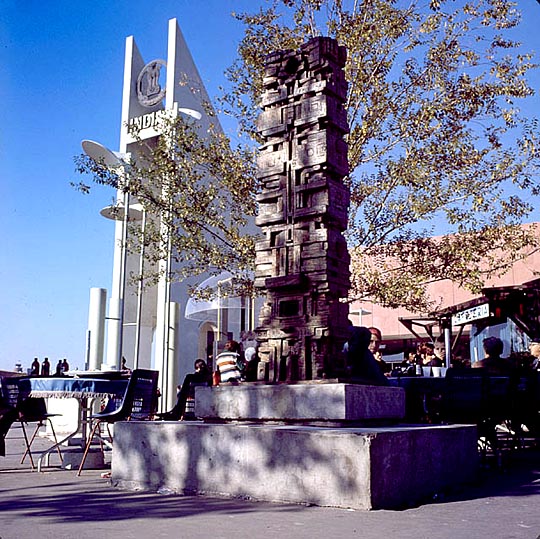India Pavilion
Although India's pavilion had a contemporary design, its use of pink sandstone, marble, teak, sandalwood and rosewood reminded visitors of mediaeval Indian architecture. Wide terraces and marble trellises cut intricate patterns in the sunlight. Large glass panels on the lower level were interspersed with jutting buttresses above which rose a windowless pink superstructure.
| India's pavilion with a contemporary look hinted at its mediaeval architectural origins. |
Inside, displays showed the skill of the Indian hand over 5000 years. The ground floor was devoted to past achievements, while the upper level showed the nation coming to grip with 20th century agriculture, industry, science and education.
A passage to the left of the entrance lead to a circular area where 1,200 slides were projected on a nine-sided screen. The show, "Journey to India," presented India's landscape, people, towns, plus its arts and crafts. It also outlined its development since independence in 1947.
The remainder of the ground floor informed the visitor about its philosophies, religions, languages and achievements in the arts, rather than about its problems of food shortages, population explosion and growing pains of industrialization. Rich tapestries, wide rolls of silks, and a giant carved ivory chess set decorated the area. Exhibits showed that in India, the cities of the Indus Valley 4000 years ago, had paved streets, drains and public baths. And in mathematics, the concept of the zero was formulated.
The escalator to the second floor took the visitor into present day India. Bicycles, typewriters and sewing machines were all part of modern India. Indians were moving into the crowded cities from the parched countryside and they were turning from traditional crafts to the factories. Displays showed that mining and manufacturing were forming the basis of their economy. And the Indians were involved with atomic research. They showed a model of their atomic research center in Trombay, which was involved in experiments where gamma radiation was used for food preservation.
But the exhibit that captivated the visitor was a modest one; a three-quarter-sized replica of the hut where Gandhi used to talk to visitors. Hanging in the front of the porch was a sample of the cloth the great leader used to weave.

| A sculpture outside India's pavilion. |